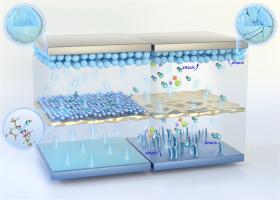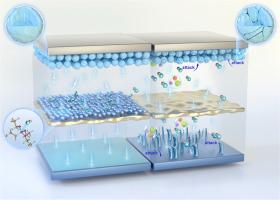长循环锂金属电池用硅烷键合石榴石电解液固氢氟分离器
IF 20.2
1区 材料科学
Q1 CHEMISTRY, PHYSICAL
引用次数: 0
摘要
具有高压阴极的锂金属电池极易受到氟化氢(HF)侵蚀而导致电极结构退化,特别是在高水分电解质中。在此,我们报道了一种氢氟固定双功能分离器,其中3-氨基丙基三乙氧基硅烷(APTES)修饰的氢石榴石电解质(Li1.5La3Zr1.5Ta0.5O7(OH)5)作为聚丙烯(PP)分离器表面的功能层。硅烷通过形成Si-F键作为HF的固定位点,有效地消除电解液中的HF并抑制阴极降解。同时,由于其高离子电导率,氢石榴石电解质增强了锂离子转移动力学,导致锂枝晶的抑制。因此,采用PP@LH-A隔膜的对称锂电池在5ma cm-2下可稳定循环2000小时。在2℃下循环500次后,Li/LiNi0.6Co0.2Mn0.2O2 (NCM622)电池的容量保持率为78.2%,即使在含有500 ppm水的电解质中也是如此。该策略为高压锂金属电池的HF固定提供了一种有前途的方法。本文章由计算机程序翻译,如有差异,请以英文原文为准。


Hydrofluoric-fixation separators through hydrogarnet electrolyte bonded by silane for long-cycling lithium metal batteries
Lithium metal batteries (LMBs) with high-voltage cathodes easily suffer from electrode structure degeneration caused by hydrogen fluoride (HF) attack, especially in electrolytes with high moisture content. Herein, we report a hydrofluoric-fixation bifunctional separator, in which 3-aminopropyltriethoxysilane (APTES) - modified hydrogarnet electrolyte (Li1.5La3Zr1.5Ta0.5O7(OH)5) serves as a functional layer on a polypropylene (PP) separator surface. The silane acts as fixation sites for HF via Si-F bond formation, effectively eliminating HF in the electrolyte and inhibiting cathode degradations. Simultaneously, the hydrogarnet electrolyte enhances lithium-ion transfer kinetics owing to its high ionic conductivity, leading to suppressions of lithium dendrites. As a result, symmetric Li cells employing PP@LH-A separators exhibit stable cycling for 2000 h at 5 mA cm-2. Li/LiNi0.6Co0.2Mn0.2O2 (NCM622) cells possess a capacity retention rate of 78.2 % at 2 C after 500 cycles, even in the electrolytes containing 500 ppm of water. This strategy offers a promising approach for HF fixation in high-voltage lithium metal batteries.
求助全文
通过发布文献求助,成功后即可免费获取论文全文。
去求助
来源期刊

Energy Storage Materials
Materials Science-General Materials Science
CiteScore
33.00
自引率
5.90%
发文量
652
审稿时长
27 days
期刊介绍:
Energy Storage Materials is a global interdisciplinary journal dedicated to sharing scientific and technological advancements in materials and devices for advanced energy storage and related energy conversion, such as in metal-O2 batteries. The journal features comprehensive research articles, including full papers and short communications, as well as authoritative feature articles and reviews by leading experts in the field.
Energy Storage Materials covers a wide range of topics, including the synthesis, fabrication, structure, properties, performance, and technological applications of energy storage materials. Additionally, the journal explores strategies, policies, and developments in the field of energy storage materials and devices for sustainable energy.
Published papers are selected based on their scientific and technological significance, their ability to provide valuable new knowledge, and their relevance to the international research community.
 求助内容:
求助内容: 应助结果提醒方式:
应助结果提醒方式:


